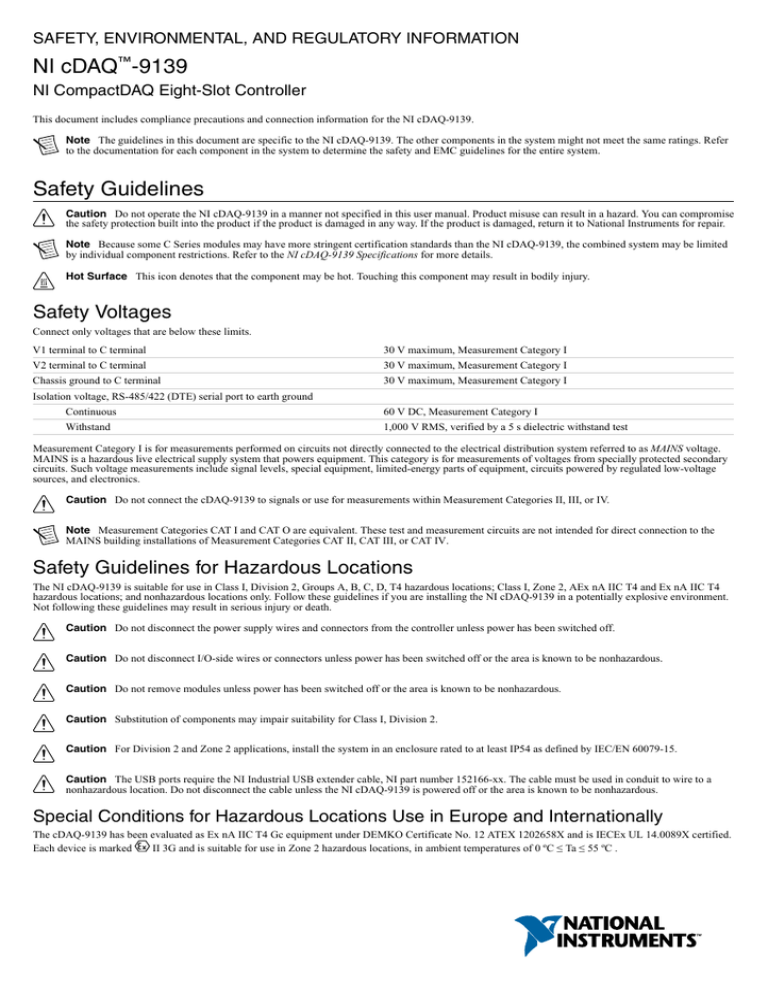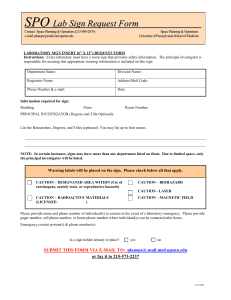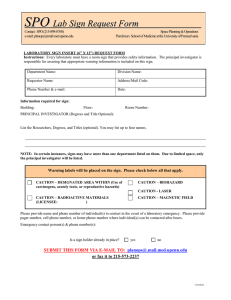
SAFETY, ENVIRONMENTAL, AND REGULATORY INFORMATION
NI cDAQ™-9139
NI CompactDAQ Eight-Slot Controller
This document includes compliance precautions and connection information for the NI cDAQ-9139.
Note The guidelines in this document are specific to the NI cDAQ-9139. The other components in the system might not meet the same ratings. Refer
to the documentation for each component in the system to determine the safety and EMC guidelines for the entire system.
Safety Guidelines
Caution Do not operate the NI cDAQ-9139 in a manner not specified in this user manual. Product misuse can result in a hazard. You can compromise
the safety protection built into the product if the product is damaged in any way. If the product is damaged, return it to National Instruments for repair.
Note Because some C Series modules may have more stringent certification standards than the NI cDAQ-9139, the combined system may be limited
by individual component restrictions. Refer to the NI cDAQ-9139 Specifications for more details.
Hot Surface This icon denotes that the component may be hot. Touching this component may result in bodily injury.
Safety Voltages
Connect only voltages that are below these limits.
V1 terminal to C terminal
30 V maximum, Measurement Category I
V2 terminal to C terminal
30 V maximum, Measurement Category I
Chassis ground to C terminal
30 V maximum, Measurement Category I
Isolation voltage, RS-485/422 (DTE) serial port to earth ground
Continuous
60 V DC, Measurement Category I
Withstand
1,000 V RMS, verified by a 5 s dielectric withstand test
Measurement Category I is for measurements performed on circuits not directly connected to the electrical distribution system referred to as MAINS voltage.
MAINS is a hazardous live electrical supply system that powers equipment. This category is for measurements of voltages from specially protected secondary
circuits. Such voltage measurements include signal levels, special equipment, limited-energy parts of equipment, circuits powered by regulated low-voltage
sources, and electronics.
Caution Do not connect the cDAQ-9139 to signals or use for measurements within Measurement Categories II, III, or IV.
Note Measurement Categories CAT I and CAT O are equivalent. These test and measurement circuits are not intended for direct connection to the
MAINS building installations of Measurement Categories CAT II, CAT III, or CAT IV.
Safety Guidelines for Hazardous Locations
The NI cDAQ-9139 is suitable for use in Class I, Division 2, Groups A, B, C, D, T4 hazardous locations; Class I, Zone 2, AEx nA IIC T4 and Ex nA IIC T4
hazardous locations; and nonhazardous locations only. Follow these guidelines if you are installing the NI cDAQ-9139 in a potentially explosive environment.
Not following these guidelines may result in serious injury or death.
Caution Do not disconnect the power supply wires and connectors from the controller unless power has been switched off.
Caution Do not disconnect I/O-side wires or connectors unless power has been switched off or the area is known to be nonhazardous.
Caution Do not remove modules unless power has been switched off or the area is known to be nonhazardous.
Caution Substitution of components may impair suitability for Class I, Division 2.
Caution For Division 2 and Zone 2 applications, install the system in an enclosure rated to at least IP54 as defined by IEC/EN 60079-15.
Caution The USB ports require the NI Industrial USB extender cable, NI part number 152166-xx. The cable must be used in conduit to wire to a
nonhazardous location. Do not disconnect the cable unless the NI cDAQ-9139 is powered off or the area is known to be nonhazardous.
Special Conditions for Hazardous Locations Use in Europe and Internationally
The cDAQ-9139 has been evaluated as Ex nA IIC T4 Gc equipment under DEMKO Certificate No. 12 ATEX 1202658X and is IECEx UL 14.0089X certified.
Each device is marked
II 3G and is suitable for use in Zone 2 hazardous locations, in ambient temperatures of 0 ºC ≤ Ta ≤ 55 ºC .
Caution You must make sure that transient disturbances do not exceed 140% of the rated voltage.
Caution The system shall only be used in an area of not more than Pollution Degree 2, as defined in IEC 60664-1.
Caution The system shall be mounted in an ATEX/IECEx-certified enclosure with a minimum ingress protection rating of at least IP54 as defined in
IEC/EN 60079-15.
Caution The enclosure must have a door or cover accessible only by the use of a tool.
Power Requirements
You must use a UL Listed ITE power supply marked LPS with the NI cDAQ-9139.
Caution The protection provided by the NI cDAQ-9139 can be impaired if it is used in a manner not described in the user documentation.
Note Some C Series modules have additional power requirements. For more information about C Series module power requirements, refer to the
C Series module(s) documentation.
Note Sleep mode for C Series modules is not supported in the NI cDAQ-9139.
Voltage input range
9 V to 30 V (measured at the NI cDAQ-9139 power connector)
Maximum power consumption1
75 W
Recommended power supply
100 W, 24 V DC
Note The maximum power consumption specification is based on a fully populated system running a high-stress application at elevated ambient
temperature, and with all C Series modules, CXM devices, and USB devices consuming the maximum allowed power.
Power Connector Characteristics
Screw-terminal wiring
Gauge
3.0 mm2 (12 AWG) copper conductor wire
Wire strip length
7 mm (0.276 in.) of insulation stripped from the end
Temperature rating
85 °C
Torque for screw terminals
0.5 N · m to 0.6 N · m (4.4 lb · in. to 5.3 lb · in.)
Wires per screw terminal
One wire per screw terminal
Connector securement
Securement type
Screw flanges provided
Torque for screw flanges
0.5 N · m (4.4 lb · in.)
Wiring Power to the NI cDAQ-9139
The NI cDAQ-9139 requires an external power source as described in the Power Connector Characteristics section. The NI cDAQ-9139 filters and regulates
the supplied power and provides power to all of the modules. The NI cDAQ-9139 has a primary power input, V1, and a secondary power input, V2. The
POWER LED on the front panel identifies the power input in use. When the LED is lit green, V1 is in use; when the LED is lit yellow, V2 is in use.
Caution Do not connect V2 to a DC MAINS supply or to any supply requiring a connecting cable longer than 3 m (10 ft). A DC MAINS supply is a
local DC electricity supply network in the infrastructure of a site or building.
Complete the following steps to connect a power source to the NI cDAQ-9139.
1. Make sure the power source is turned off.
2. Install the ferrite (National Instruments part number 711849-01, included in the shipping kit) across the negative and positive leads of the power source,
approximately 50 mm to 75 mm (2 in. to 3 in.) from the ends of the leads near the NI cDAQ-9139.
3. Loosen the connector screw flanges and remove the power screw terminal connector plug from the NI cDAQ-9139.
Note Do not tighten or loosen the terminal screws on the power connector while the power is on.
4.
5.
6.
7.
8.
Connect the positive lead of the primary power source to the V1 terminal of the power connector plug and tighten the terminal screw.
Connect the negative lead of the primary power source to one of the C terminals of the power screw terminal connector plug and tighten the terminal screw.
Optionally, you can connect the positive lead of a secondary power source to the V2 terminal and the negative lead to the other C terminal.
Install the power connector plug on the front panel of the NI cDAQ-9139 and tighten the connector screw flanges.
Turn on the external power source(s).
1
Includes maximum 1 W module load per slot across rated temperature and product variations.
2
| ni.com
|
NI cDAQ-9139 Safety, Environmental, and Regulatory Information
The cDAQ controller uses V1 if the voltage across V1 and C is 9 V or greater. If the V1-to-C voltage drops below 9 V, the NI cDAQ-9139 switches to V2. If
the V2-to-C voltage is less than 9 V, operation may be interrupted.
Note If the NI cDAQ-9139 is using V1 and a secondary power source is connected to V2, there is a small leakage current on V2. The leakage current
depends on the V2-to-C voltage. Refer to the NI cDAQ-9139 Specifications for nominal values of this leakage current.
If the power source is connected to the power connector using long wiring with high DC resistance, the voltage at the power connector may be significantly
lower than the specified voltage of the power source.
The C terminals are internally connected to each other but are not connected to chassis ground. You can connect the C terminals to chassis ground externally.
Refer to the Power Requirements section for information about the power supply input range. Refer to the Safety Guidelines section for information about the
maximum voltage from terminal to chassis ground.
Preparing the Environment
Ensure that the environment you are using the NI cDAQ-9139 in meets the following specifications.
Temperature (IEC 60068-2-1 and IEC 60068-2-2)
Operating
0 ºC to 45 ºC
Operating with NI panel mount kit (part number 781919-01)
0 ºC to 55 ºC
Storage
-40 ºC to 85 ºC
Caution Failure to follow the mounting instructions in the NI cDAQ-9138/9139 User Manual can cause temperature derating. For more information
about mounting configurations and temperature derating, go to ni.com/info and enter Info Code cdaqmounting.
Pollution Degree (IEC 60664)
2
Maximum altitude
2,000 m
Indoor use only.
Note Refer to the NI cDAQ-9139 Specifications for complete specifications.
Electromagnetic Compatibility Guidelines
This product was tested and complies with the regulatory requirements and limits for electromagnetic compatibility (EMC) stated in the product specifications.
These requirements and limits provide reasonable protection against harmful interference when the product is operated in the intended operational
electromagnetic environment.
This product is intended for use in industrial locations. However, harmful interference may occur in some installations, when the product is connected to a
peripheral device or test object, or if the product is used in residential or commercial areas. To minimize interference with radio and television reception and
prevent unacceptable performance degradation, install and use this product in strict accordance with the instructions in the product documentation.
Furthermore, any changes or modifications to the product not expressly approved by National Instruments could void your authority to operate it under your
local regulatory rules.
Caution To ensure the specified EMC performance, operate this product only with shielded cables and accessories. Note that the input DC power
cables may be unshielded.
Caution To ensure the specified EMC performance, do not connect V2 to a DC MAINS supply or to any supply requiring a connecting cable longer
than 3 m (10 ft). A DC MAINS supply is a local DC electricity supply network in the infrastructure of a site or building.
Caution To ensure the specified EMC performance, the length of any cable connected to the video port must be no longer than 3 m (10 ft). The
length of any cable connected to the RS-232, USB, and MXI-Express ports must be no longer than 30 m (100 ft).
Caution To ensure the specified EMC performance, install snap-on, ferrite bead (National Instruments part number 711849-01, included in the
shipping kit) in accordance with the product installation instructions.
Special Conditions for Marine Applications
Some products are Lloyd’s Register (LR) Type Approved for marine (shipboard) applications. To verify Lloyd’s Register certification for a product, visit
ni.com/certification and search for the LR certificate, or look for the Lloyd’s Register mark on the product.
Caution In order to meet the EMC requirements for marine applications, install the product in a shielded enclosure with shielded and/or filtered
power and input/output ports. In addition, take precautions when designing, selecting, and installing measurement probes and cables to ensure that the
desired EMC performance is attained.
Connecting to the cDAQ Controller
Connecting to the Network through the Ethernet Port
Caution To prevent data loss and to maintain the integrity of your Ethernet installation, do not use a cable longer than 100 m.
NI cDAQ-9139 Safety, Environmental, and Regulatory Information
|
© National Instruments
|
3
Connecting to the Video (VGA) Port
Caution Do not hot-swap VGA devices while the NI cDAQ-9139 is in a hazardous location or connected to high voltages.
Connecting to the USB Ports
Caution Do not hot-swap USB devices while the NI cDAQ-9139 is in a hazardous location or connected to high voltages. If the NI cDAQ-9139 is
not in a hazardous location, you can connect and disconnect USB devices without affecting operation.
Where to Go Next
The following documents contain information that you may find helpful as you use this document:
• NI cDAQ-9138/9139 User Manual
• NI cDAQ-9139 Specifications
Worldwide Support and Services
NI corporate headquarters is located at 11500 North Mopac Expressway, Austin, Texas, 78759-3504. NI also has offices located around the world. For
telephone support in the United States, create your service request at ni.com/support or dial 1 866 ASK MYNI (275 6964). For telephone support outside the
United States, visit the Worldwide Offices section of ni.com/niglobal to access the branch office websites, which provide up-to-date contact information,
support phone numbers, email addresses, and current events.
Refer to the NI Trademarks and Logo Guidelines at ni.com/trademarks for information on NI trademarks. Other product and company names mentioned herein are
trademarks or trade names of their respective companies. For patents covering NI products/technology, refer to the appropriate location: Help»Patents in your software, the
patents.txt file on your media, or the National Instruments Patent Notice at ni.com/patents. You can find information about end-user license agreements (EULAs) and
third-party legal notices in the readme file for your NI product. Refer to the Export Compliance Information at ni.com/legal/export-compliance for the NI global trade
compliance policy and how to obtain relevant HTS codes, ECCNs, and other import/export data. NI MAKES NO EXPRESS OR IMPLIED WARRANTIES AS TO THE
ACCURACY OF THE INFORMATION CONTAINED HEREIN AND SHALL NOT BE LIABLE FOR ANY ERRORS. U.S. Government Customers: The data contained in this
manual was developed at private expense and is subject to the applicable limited rights and restricted data rights as set forth in FAR 52.227-14, DFAR 252.227-7014, and
DFAR 252.227-7015.
© 2016 National Instruments. All rights reserved.
374089B-02
Mar16


